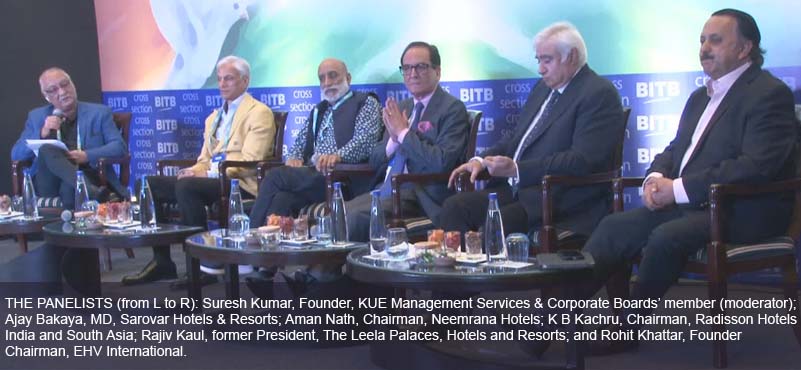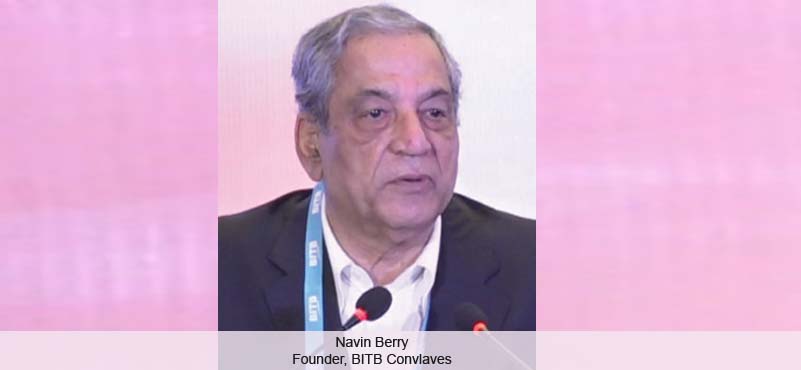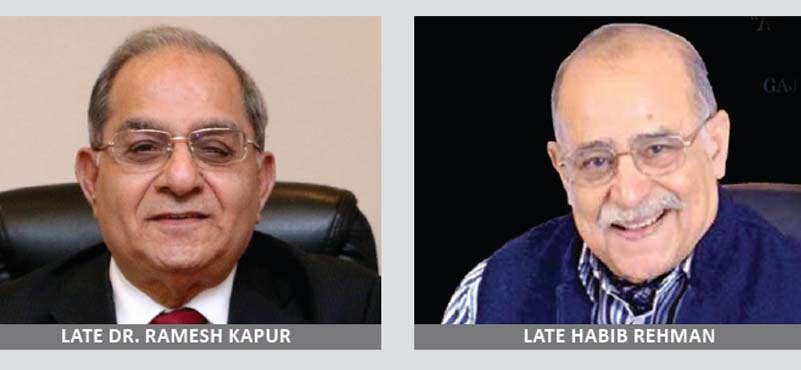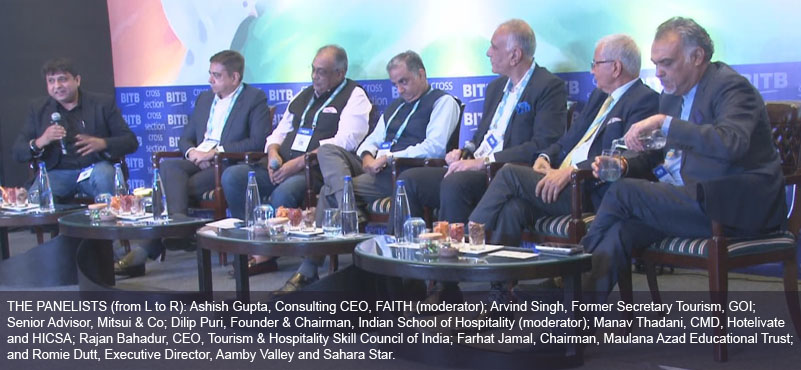Share the post "Growth Amidst Challenges: Chasing Sustainability in Business"
Rattan Keswani: The whole day has been about unprecedented growth. It’s going to happen. It’s an India story. And otherwise, we are all fine. The market is good. The only challenge is people. So, let’s kind of try and dissect this a little. So, we have a wonderful array here, some young Turks, some large corporations.
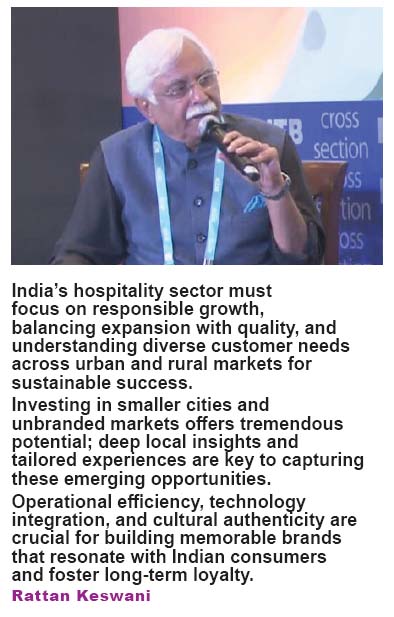 To start with you, as the newest entrant, into what Sindhudurg Development Authority is doing, quick introduction to what it is all about, because it’s very different as I read from what everybody else is doing. Why did you go that route and would you think that would succeed more than the others?
To start with you, as the newest entrant, into what Sindhudurg Development Authority is doing, quick introduction to what it is all about, because it’s very different as I read from what everybody else is doing. Why did you go that route and would you think that would succeed more than the others?
Akash Timblo: I think that’s a very poignant question. Because, the route actually is something which I think would possibly not pass a data driven feasibility test today. If somebody was to say, where would you go to invest, these are the different locations. So, it actually was more than a project, it was a quest. And it still remains a quest in an area which I think potentially, could be one of the best coastal destinations in the country.
And the quest really is, there are many things which were missing at the beginning, the story of Goa, like what was the connectivity, it was just Goa and at that time you had the South Goa airport and MOPA was not even in the vicinity of being a reality. But one decided to get into it, to say that if I decided to stay in this with an absolute long-term vision, I would just have to sustain the first initial build, and then see how the infrastructure would come up behind me. So, and I think with that kind of an attitude, something which we possibly saw when (and just to give me a little introduction to myself, I grew up in the Cidade de Goa family), when in Goa, for the longest time, you saw just a few resorts, Fort Aguada, Cidade de Goa, the Village, and then a few others, we had just a few flights. And it was actually my parents who lobbied with the government to start charter airlines into Goa to try and to sort of just add an alternative to just coming in from one domestic flight. And so these are things where sometimes when there’s the reality of a location, that what will work here, but there’s also the journey to create a certain reality, and so it is, what is valuable about Sindhudurg, I think the coastal beauty of that area, what we’ve built there, is a small milestone – in saying what is the potential in this and that’s the reason.
Rattan Keswani: In terms of heritage, structure, culture, locale, is there something specific that you should wish to be known for people to experience which is different from run of the mill?
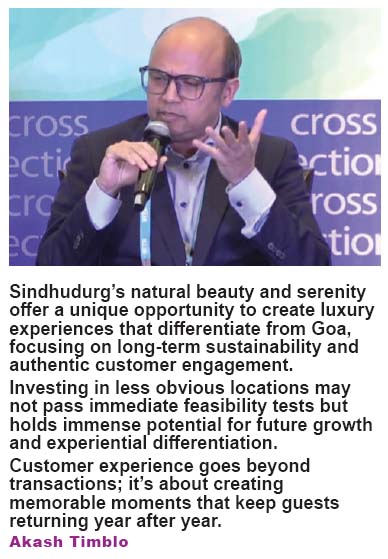 Akash Timblo: My location in specific is that the confluence of pristine beach, which you’ve probably seen in the Caribbean or in Maldives or in other premium beach locations, river and hill and just being completely away from it all and I think that itself, these are the basic ingredients to make other locations in that destination into something where luxury premium resorts can reside. What happens is, how to differentiate it from the mother node of Goa is that you always looked that Goa was that first foreign destination that an Indian person came to before he actually discovered true foreign destinations and I think now to differentiate Sindhudurg, where can you have and when you know how Goa is moving, in a sort of very fast-paced urbanization, which is good and bad and debatable, I think here is where you have to turn attention, to what can premium luxury beach tourism provide.
Akash Timblo: My location in specific is that the confluence of pristine beach, which you’ve probably seen in the Caribbean or in Maldives or in other premium beach locations, river and hill and just being completely away from it all and I think that itself, these are the basic ingredients to make other locations in that destination into something where luxury premium resorts can reside. What happens is, how to differentiate it from the mother node of Goa is that you always looked that Goa was that first foreign destination that an Indian person came to before he actually discovered true foreign destinations and I think now to differentiate Sindhudurg, where can you have and when you know how Goa is moving, in a sort of very fast-paced urbanization, which is good and bad and debatable, I think here is where you have to turn attention, to what can premium luxury beach tourism provide.
Rattan Keswani: Lots of growth, it will be in regional centers, it will be tier 2, tier 3, it will be far-flung results, it’ll be experiential. For all of you one by one, are the numbers truly stacking up or are the numbers really for the 12, 15, 18 locations that everybody’s tracking? And while sustainability as a subject seems to have kind of petered off, but we’d say sustainable growth and profit. Is it still going to be linked up largely in the 12, 18, 20 maximum locations and the
rest will be additive, will pick up someday. Will you find a solution to the staffing. Because let me start with Ashish, you’re concentrating largely as I understand and correct me, in the recent past, if your direction has changed in the tier one, tier two cities, you wish to be an asset lead.

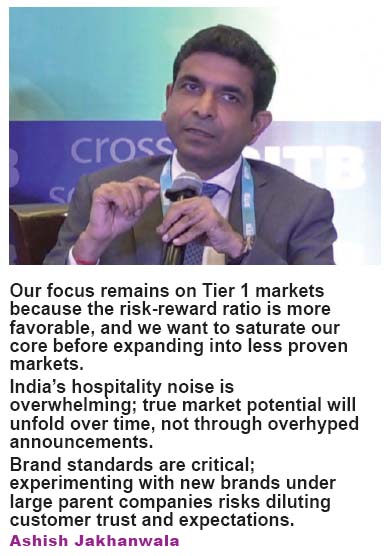 Ashish Jakhanwala: Only tier one. Every company has a circle of competence and you create the best risk reward in that circle of competence. So, I think I must fully admit that that’s the core reason that our circle of competence is tier one business hotels. Not going to tier two, tier three is not a disbelief in those markets. It’s just that we worry that the economics will not stack up to the extent we want them to. And when I say we want them to, there are two things there. One is what sort of a return you want, what sort of a risk you’re willing to take for that return, and what’s your time horizon. And I think when I look at these three things, we feel a little uncomfortable about rapid investment in tier two, tier three, there could be great success stories there. But if I want to replicate that across 15, 20, 25 tier two, tier three markets, we feel risk reward and the timelines we have may not stack up. And in the end, we represent institutional capital, which tends to be, for lack of any other word, sometimes lazy. And we think the opportunities in tier 1 are 3x of what we are doing right now. So, till such time, we don’t saturate our home base as they say, we don’t find compelling reasons to create a second circle of competence to understand tier 2, tier 3 or even for that matter leisure. But does not mean we have a disbelief in the opportunity per se, it’s just that we don’t think the returns for us stack up comfortably in those markets today.
Ashish Jakhanwala: Only tier one. Every company has a circle of competence and you create the best risk reward in that circle of competence. So, I think I must fully admit that that’s the core reason that our circle of competence is tier one business hotels. Not going to tier two, tier three is not a disbelief in those markets. It’s just that we worry that the economics will not stack up to the extent we want them to. And when I say we want them to, there are two things there. One is what sort of a return you want, what sort of a risk you’re willing to take for that return, and what’s your time horizon. And I think when I look at these three things, we feel a little uncomfortable about rapid investment in tier two, tier three, there could be great success stories there. But if I want to replicate that across 15, 20, 25 tier two, tier three markets, we feel risk reward and the timelines we have may not stack up. And in the end, we represent institutional capital, which tends to be, for lack of any other word, sometimes lazy. And we think the opportunities in tier 1 are 3x of what we are doing right now. So, till such time, we don’t saturate our home base as they say, we don’t find compelling reasons to create a second circle of competence to understand tier 2, tier 3 or even for that matter leisure. But does not mean we have a disbelief in the opportunity per se, it’s just that we don’t think the returns for us stack up comfortably in those markets today.
Rattan Keswani: So let me add to that question more in being a vocal hospitality expert for many many years. Therefore, would you say that the pronouncements, the general pronouncements about the depth and the width of the market in these kinds of cities, in the same cookie cutter approach that people are following those modern number of rooms, is a bit of overplay and a misnomer or they are playing a long game, though they say it’s a sequence that will work in the short term?
Ashish Jakhanwala: I don’t know Mr. Keswani, I’ve not really looked at the honesty of the announcements. I think there’s a lot of noise. There’s just way too much noise in this sector and there’s noise in every sector, by the way. But we also have to respect the fact that other sectors have grown to be very large size. So, the proportion of noise to the size of the sector is tolerable. Our sector is still tiny, and probably the noise is not a percentage of our sector, it’s multiples of a sector. So, I think that worries me, that there’s just too much noise. Now I started by saying I have no statistical evidence of saying what I’ve just said, but my interpretation is that when I hear the announcements, it may be true, but it may take much longer.
As I said, I don’t ever bet for somebody to fail. I only evaluate whether there’s a plan to succeed.
Rattan Keswani: So, coming to Aryavir, newest, fastest growing mavericks if I may call both of you, in your Clarks Hotels as well as the Brij part of it. Some keeping to heritage culture similar to the Manesar piece and you know Neemrana Hotels in a manner if I may say. The others going in a different route. You’ve largely been specializing in the two and three tier regions. Do you still believe that whatever is being announced and set up is truly as this title says truly sustainable, if I may use that word loosely, as an overplay? And what could be the challenges other than the availability of talent? What could they be that people are, while they might know it, they’re not really focusing or sharing with us.
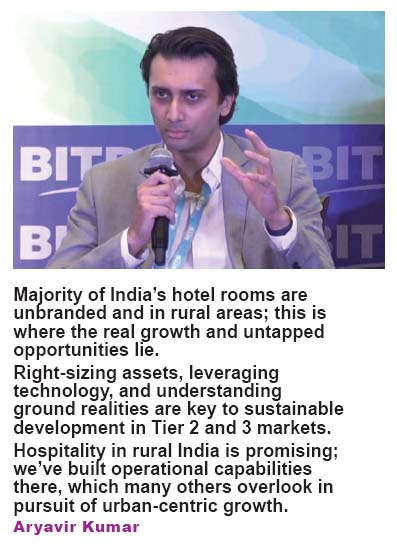 Aryavir Kumar: Before that, I’d like to just touch upon what Ashish said. It was quite significant. So, building assets and owning assets is a very different play to actually managing assets. So they’re more sort of, obviously, they own all of their hotels, even for us, maybe 120 hotels are on management contracts, but the rest, only 10 we own, and those are majorly in tier one locations. So, the capital appreciation that we have seen in owning hotels in tier one has been far greater than even all the managed hotels combined. When it comes to the development of the landscape of hotel development, I mean, of course, I was reading the Hotelelivate statistics, there are more hotels being signed, but very little are opening out.
Aryavir Kumar: Before that, I’d like to just touch upon what Ashish said. It was quite significant. So, building assets and owning assets is a very different play to actually managing assets. So they’re more sort of, obviously, they own all of their hotels, even for us, maybe 120 hotels are on management contracts, but the rest, only 10 we own, and those are majorly in tier one locations. So, the capital appreciation that we have seen in owning hotels in tier one has been far greater than even all the managed hotels combined. When it comes to the development of the landscape of hotel development, I mean, of course, I was reading the Hotelelivate statistics, there are more hotels being signed, but very little are opening out.
So, of course, signings have been at an absolute record pace, 44,000 rooms or something last year, something like that, but I think only 13,000 rooms actually opened out, if I’m not wrong. So, where I feel the challenge lies is that majority of India is in the rural parts, right? So I think only 5% of the entire industry, the branded rooms are of the total industry size, right? So, 180,000, 200,000 rooms versus 10 million rooms, which are unbranded. So that’s where majority of the majority of the rooms lie.
I mean, $7 billion worth of revenue generation from branded and $17 billion from unbranded. So obviously, 8,000, 7,000, 6,000 ADRs are quite large for majority of the India to afford. So, what I’m trying to say is that I believe, that we believe in tier 2, tier 3 strongly. We’re there. We built operational capabilities in remote areas, gotten to know the people, got to know the panchayats, got to know the absolute ground reality and that’s where we thrive and that’s where our expertise lies.
Rattan Keswani: So it has to be, let’s say an amended story. Would you be safe to say that?
Aryavir Kumar: I would say that I’m very optimistic about where it’s going in the mid-scale segment, very very optimistic about that.
Rattan Keswani: JB, you and I were talking, are the pronouncements a little bit like all the FMCG and FMNC announcements over the past. You know the markets are like in the rural areas and tier two, three cities, it just needs different packaging. People haven’t really tested and felt and eaten what we can do and once we kind of bring it together, it will. Largest middle class growing market, largest you know earning capacity and that’s the kind of story in a bit of a similar manner that I see echoing in the hospitality industry. What is right about the sound waves and what should be the amendment and you said you guys are working a little bit on it. What is this all about?
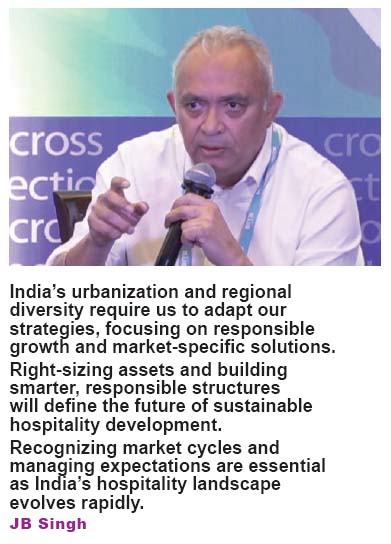 JB Singh: Yeah, so I think there are multiple views around this and then for us when we look at India and if I was to just use the word diversity, India comes with its own diversity. So, on one side you have this big global trend and we obviously have that in India as well, is urbanization. Delhi by 2030 will become the largest mega city in the world and India will throw up seven mega cities. So, there’s that one definite trend of urbanization, which means cities like Delhi, NCR will have 8 or 9 or 10 ecosystems running and can take significant amount of capacity as they build out and that will happen across many other cities. And then you have the next layer of cities that are coming up and the so-called tier 2, borderline tier 1 and we’ll start to mirror the current tier 1 over the next 10 years and so on and so forth.
JB Singh: Yeah, so I think there are multiple views around this and then for us when we look at India and if I was to just use the word diversity, India comes with its own diversity. So, on one side you have this big global trend and we obviously have that in India as well, is urbanization. Delhi by 2030 will become the largest mega city in the world and India will throw up seven mega cities. So, there’s that one definite trend of urbanization, which means cities like Delhi, NCR will have 8 or 9 or 10 ecosystems running and can take significant amount of capacity as they build out and that will happen across many other cities. And then you have the next layer of cities that are coming up and the so-called tier 2, borderline tier 1 and we’ll start to mirror the current tier 1 over the next 10 years and so on and so forth.
So, I think the fundamental thing is India’s race to the third largest economy, 5 trillion, 6 trillion, 7 trillion, whatever those numbers are. It’s consistent growth, anything between 5 to 7% GDP will trigger travel and connectivity and everything else that all of us know about. But I do echo what Aashish said, for us it’s been going into markets with clear and present demand as Ajay Bakaya said, ultimately for the business to be sustainable, the numbers need to add up. And we’ve learned that over 20 years, that stick to what you know. Having said that, as we look at tier 2 markets and maybe tier 3 at some point, we need to right size the assets. I think Manav spoke about building smarter buildings, responsible buildings, tighter buildings, manning is an issue, we know that, it will continue to become bigger and bigger. So we have multiple models that we are now testing. I am telling you, for us, it’s all about reducing GFA. Our teams fight for 0.2 square meter of GFA and that debate can go on for hours. Every building is starting to get mapped tighter and tighter and tighter. We debate ceiling heights, it’s a debate. 12 feet, 11 feet, air conditioning costs. Why is that extra area there? Who’s going to man it?
Why are outdoor, your horticulture landscapes unnecessarily, and so on and to every point, is this extra space and lobby that is being mapped out going to give you revenue? If it’s not, take it away, resize the building. And today now you have AI to do architectural work. So, it’s becoming very scientific. We believe we understand it far better than we did 15 years ago. We are getting very, very good at it. Our mannings are possibly one of the tightest that helps us, energy costs and then all the other stuff. So, one has to be very, very careful which market, sizing and by just the population and the landmass in India, real estate will come at a premium and we are a real estate hungry industry. If you keep right sizing the assets and work with people in other markets who understand those markets better, we don’t. And that’s the way to possibly cautiously crack this thing.

Rattan Keswani: So, the advantage, the knowledge and where you come from, the business perspective between interglow, you Ashish, to a particular point, Aryavir, you are defining it because you are the investor, when you want the last cent to come from the space and the earning.
Whilst on the other side, largely as I understand and sorry, Zubin, there don’t mean any criticism. The brands are not specifying and picking that up both as an opportunity to give you as knowledge, you are forcing it on them with logic. Would you not think it is as much their responsibility to now look at brand standards from this opportunity in the tier two differently without pressure from you guys as investors because it’s just the right thing to do for the investor and the owner as well as specifically for the buying power of the customer. Why are they not so expansive on that?
Ashish Jakhanwala: Not so difficult, it’s a separation of P&L from the ownership. It’s not that you have to push them, but I think this industry suffers from a fundamental construct of separation of who runs the P&L and who owns the hotel, right? Because money hurts and that’s a reality and it hurts the owner a lot more than it hurts the operator. But having said that, I think operators have done their bit to collaborate, to respond to what the requirements of the markets are. I don’t think we lack that collaboration. I mean, I give an example, we converted a whole portfolio to Holiday Inn Express. It’s 14 square meter room. They didn’t have that brand standard anywhere else in the world, not in Asia.
It has done reasonably well. It has its own challenges, there’s complete inelasticity of product at 14 square meters, but nevertheless, that experiment has worked. I think they’re doing their bit. But India is a market where you need to, it’s not a subset of the global anymore for a large company. India is an independent country and economy which requires its own product and solutions.
So owners in India have to take lead and collaborate with international operators or domestic operators to find the right product service mix and I think it’s happening, should happen faster but clearly happening.
Their mandate is different. Their mandate is distribution. Their mandate is to build distribution and they’re building distribution by A, B, C, D, E, F, G. I think there are hundreds of hotel brands today. If you know, for an owner to look at, I don’t think even hotel companies understand their own brands, but I understand it’s not about brands, it’s about distribution. It’s no longer about brands. Let’s call a spade a spade, right? They’re only working for distribution, not for the brands. So we know what they’re doing and we need to know what we are doing actually. So it’s a clear separation of responsibilities.
Rattan Keswani: Zubin, Hilton came in a long time ago, 86, 87, kind of slowed down, came up with the truck with it Trident, kind of went into a sleepy giant mode. Now suddenly since you’ve taken over, something is the star has been born in terms of the brand and yourself. What are you doing differently very quickly and is this part of the mandate that we just talked about that’s going to be new other than some soft brands that somebody spoke about. So what’s causing the acceleration, where is it going to be and truly which part is going to be sustainable profit?
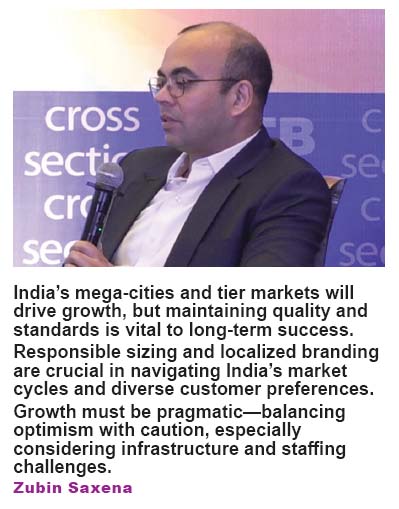 Zubin Saxena: I think what we are doing differently is to Ashish’s point taking ownership of the P&L and putting ourselves in the ownership’s shoes. And Hilton in India, I consider it to be actually the silver lining of the cloud. Because the portfolio was until two years ago, relatively smaller size portfolio, that allowed the company was a complete white space opportunity in this market. We still have hardcore deployable brands, very high recall brands like Hilton, Hilton Garden Inn, Waldorf, Conrad, Hampton. And for for us India is really the playground. So and there’s a lot that’s been said on this panel before. So one of it is how, the brands are just perhaps completely choosing to ignore the market realities and chasing growth. My view and our view is as follows.
Zubin Saxena: I think what we are doing differently is to Ashish’s point taking ownership of the P&L and putting ourselves in the ownership’s shoes. And Hilton in India, I consider it to be actually the silver lining of the cloud. Because the portfolio was until two years ago, relatively smaller size portfolio, that allowed the company was a complete white space opportunity in this market. We still have hardcore deployable brands, very high recall brands like Hilton, Hilton Garden Inn, Waldorf, Conrad, Hampton. And for for us India is really the playground. So and there’s a lot that’s been said on this panel before. So one of it is how, the brands are just perhaps completely choosing to ignore the market realities and chasing growth. My view and our view is as follows.
You have to focus on the fundamentals and you have to build the business right. I think we have a great opportunity to do that. And that is what we are choosing to do at this point in time. So we have, our stated market ambition was to cross 75 hotels by 2027. Let me please tell you that we actually crossed that mark in July this year. And then that 75 will very soon become 100 will go to so on and so forth. A lot of it is the market has momentum at this point in time. And that’s just not a Hilton advantage. I think that’s a market advantage, and the market will continue to grow. So, I think we are sailing that tide also with the others. I think what’s important in that is that, and over the last 1 and 1 1⁄2 years, we indeed have announced big plans ourselves of growth.
The real statistic in all of that is 60% of the growth of the deals that we have announced, 60 to 70% are actually hitting construction or have hit construction already. That’s a pretty good metric. There’ll always be a wash in the business, but the wash in the Hilton pipe is not going to be that much strong. Why? Because we are focusing on the fundamentals in the market. Focus on quality. And I think we are chasing growth. More importantly, we are chasing quality. If you look at the quality of tie-ups that is happening, the quality of partnerships that are happening, for example, the Waldorf and Hilton at Delhi GMR. So that 25 very quickly becomes 75, we’ll go to 100 maybe first quarter next year so on and so forth.
We are, in the long term focusing on opening these hotels right. And secondly putting ourselves in the owner’s shoes by localizing to a great extent. When we launch Spark, for example, which is a brand based out of the US and when we launched Hampton, which is a no F&B brand, we actually went through a full exercise in this market. And we went through almost six to eight months of market research, market demand analysis, what the customer preferences are, and we localized that to the Indian market. I think I don’t want to comment on what everybody else is doing, I can talk to our approach.
Our approach is very robust and I think it might take us a little bit longer to get to where we want, that’s all right. I think ultimately and the way this market is maturing, also just the nature of ownerships, and there was a question about you know tier 1 markets and tier 2 markets. I think to me and having beyond Hilton run other hotel companies and having exposure across various markets I think that’s driven by the nature of the ownership that is driven by what is the cost to own that land, if there is a historical cost of land, if it is generational land, clearly to the last, to the current generation, it’s cheap to build that hotel. So hence, their holding power in a tier 2 or tier 3 or even a tier 4 market is much more than hasty institutional capital which is seeking a return every 5 to 7 years.
Rattan Keswani: Coming back to you Akash, give me two quick thoughts on what you still believe the classical hoteliers seem to miss.
Akash Timblo: So just to get an idea that so a classical hotelier or a conventional hotelier, I think it’s not that what it’s missing, but I think what can be brought in is that at some level after all our feasibility studies, after all the investments and the numbers, and I’m talking here just specifically from Goa and the new project which are you know in a leisure destination. I think we should know that finally the customer we’re not giving them a transaction, we’re giving them an experience and if Goa wants to start moving to an area where you’ve got your sun, sand, sea, you’ve got your buffet and you’ve got your beach, what else do you have to entertain the guests when they’re for them to return year after year? I mean, if especially when you look at what’s happening outside the hotel where Goa is rapidly urbanizing, a lot of real estate is coming in, what was that lovely beach shack that you thought was a secret is now completely taken over and the experiential aspect of it is gone, which is very critical for leisure destinations. So I think what really all the hoteliers or the classic hoteliers in Goa would have to say is, how can I keep this person in my campus, in my building, in my area and give them some reason to keep returning other than food and beverage in a room.
Rattan Keswani: Just the normal hospitality but what’s typical, what’s local, what’s the enjoyment, what’s the difference? Changing tack a little bit, lots of questions that came up when I was moving around earlier from some other parts. We’ve suddenly had a slew of announcements, one on new soft brands and I’ll ask everybody for your opinion and why do you think that’s happening? Is it a diffidence? Is it a new market? Soft brands, then Marriott sign up with the Fern and the investment in CG hotels. You guys and your setup with Treebo what do you believe is the reason for it, or is it one more channel of evolution, which benefits from the larger distribution, or it shows a diffidence in being able to manage some markets and some sizes of the hotels? So let that be taken on by somebody else. And let me take care of the master distribution and the cost and revenues that come with it.
We’ll switch the direction. Aryavir, as you’re the watcher, a little bit of a competitor in that business, your opinion and what do you believe is the true reason? And would you think as a customer that makes sense?
Aryavir Kumar: I think it’s very interesting what’s happening. Because I think the larger players, it’s very difficult and not sustainable or even worth their time and money to really go out there to tier 2, tier 3, tier 4, 30 room hotel, 40 room hotel and try and make returns because at the end of the day they are catering to shareholder value. We understand that as well. And for us, brands like us, domestic, family-owned businesses, we also understand where our weaknesses lie, they lie in technology, absolutely. I mean if you were to ask us to put a 1 crore rupee opera in a 50-room hotel or a 60-room hotel, that’s impossible, but of course there are multiple opportunities, alternatives out there now. But yes, distribution is a huge part of the entire landscape and I would say that us as a domestic player would love to connect with a partner who has the technology and distribution and I’m sure for the brands as well, for them to get a portfolio of hotels in cities where it’s difficult to develop themselves and operate.
Rattan Keswani: So you’re pitching to some of the guys who haven’t done it to say we are available for a marriage. Is there a risk into true brand essence by too much of this kind of way of going in that direction? So, Ashish, you want to go for it and then we’ll go for the guys who are actually doing it.
Ashish Jakhanwala: Let me give an extreme point of view so that if nothing it excites some conversation. I think it’s a very flawed strategy. Okay, it’s going to, I don’t know what are they trying to do. Let’s break it up. Hotel companies as much as the thing they have great brands, they suck at branding. Completely miserable at branding, even at a corporate level. And let me try and tell you what I’m saying here. Zomato. What did Dipendra Goel do few months back? He renamed his public company Eternal. Why? Because he’s going to run very different businesses and he’s a smart man who never wanted the failure of a new enterprise to reflect on the parent. A lot of consumer companies do that. You would not even know a new brand which just died in the market was owned by Unilever’s. It would not rub off on Unilever’s. Hotel companies don’t get this. So under the parent brand, they will sign experimentative brands. And if those brands fail, the customer will look at that brand and say, what the heck is this?
You know, so I feel it’s a strategy full of risk, poorly thought through, though the intent was right. The intent was Microsoft can buy WhatsApp. And when they bought WhatsApp, WhatsApp was worth nothing. And today, WhatsApp is very valuable. But WhatsApp remained WhatsApp. It was not Microsoft WhatsApp. I don’t understand why is Spark by Hilton? Or why is that thing by Marriott? Or why is something else by somebody else? If you want to experiment with a new customer and a new segment, for God’s sake create a new company. If that company succeeds, you’ve got a great entrepreneurial success and if it fails, ignore it. Your main customer, your main brand identity does not take a hit. So, I actually think it’s very risky. I wish them well because I’m their partners, so I don’t want them to fail necessarily. But there was a different way of doing that. And those examples are there in the consumer spaces.
Zubin Saxena: There are independent hotels with great personality but it is a hyper competitive market and there is a at some level a requirement for getting some distribution on a highly visible platform. And I think that is where this partnership works. Now, brands would not ideally like to dilute the hard-coded brands. For example, Hilton has very strict brand standards and very strict codes, right? But there are, for example, the SLH, right? The Narendra Bhawan is an SLH hotel, which is a Hilton partnership. So I think there is an ask and a want there, there is a want there, there is a synergy there. And I think that’s how this needs to be looked at. Ideally, these types cannot become the entire brand itself. They have to be a certain percentage of the brand scape. They have to be a certain small percentage of the entire portfolio.
Again, in tier two, tier three markets, tier four markets, where visibility is important for that good hotel, which does not have that core brand standard, that’s where this becomes extremely relevant.
JB Singh: I’ll address it slightly differently. One, India is going through a pattern that any growing economy globally has gone through, which means it will start to consolidate, it will start to create structures and so on and so forth. And people out there will have to go out there and do it. Somebody has got to do it, right? It’s not going to remain the way it is, that you have smaller hotels who seek to play the bigger game and be part of the bigger pie. Cities are growing, spending power is growing, et cetera. So when economies grow, they throw up several patterns. And we just have to keep recognizing them and addressing them. So that’s one.
I think your second question was how brands can be held together. I just want to just sort of backpedal to your previous question which was to Ashish and I’ll just draw a narrative from our own joint venture where Accor is deeply vested in this and with significant financial investments. So, they’ve had a sort of a hat of an owner as well as an operator. And together, one of the strengths that JV bought was we together understood the operating model as well as the development and the investment model. So, we were actually in many ways preparing ourselves on what would be the next logical step for the organization. Leadership at scale is a subject by itself and it’s not a journey for the faint-hearted. It comes fraught with challenges, but at the same time, massive opportunities that can be harnessed.
We believe we understand these challenges, and as the company is being built out, I think several building blocks are being put into place. I’m not at a liberty obviously to talk about it. What should be the big branding strategy and many other things. Someone’s going to go out there and do it. We hope we are one of those and we are very optimistic about it.
Ashish Jakhanwala: The only thing I would say I was indicating consumer’s mind. For instance, Marc Jacobs is not by Louis Vuitton. Marc Jacobs is an independent brand owned by LVMH. Similarly, there could be a brand, let’s say ABC and you don’t have to say by the main brand. My problem is that you have your entire P&L comes from your core brands, both for the owners and for the operators.
Those customers come to you seeking a certain promise and a certain standards of expectation. The same customer, when he sees that tagline, whether a prefix or a suffix or a tagline, may get hugely disappointed. And as you know, a disappointed customer doesn’t complain in our business, he just doesn’t check back in.
My worry as an owner and an investor in the brands indirectly is, why are we using the big brands prefix and suffix? I am all for creating new brands to target tier two, tier three, tier eight, tier nine, tier 10. But why are we only so dependent on those two names, tier 3, tier 8, tier 9, tier 10. But why are we only so dependent on those two names, three names, four names, five names?
Rattan Keswani: Coming from what Ashish said, Lexus, Toyota started off the same way, realized what you’re saying is right. In the present Indian scenario, in the present scenario internationally, with what is happening right, would you think the title saying great growth, great possibility that everybody spoke about other than little staffing challenges, would you want to still keep on the optimistic tone of the subject or would you say I think it’s time to be step back and be a little optimistically conservative maybe because some realities we aren’t seeing just a yes and no answer from everybody so would you say yes or no.
Akash Timblo: I would say yes.
Aryavir Kumar: So I look at this more as a business sort of risk because we aren’t just in hospitality. So, I’d look at hospitality as one angle and then textile which is another significant part of our business. So I would say hospitality is going okay.
Ashish Jakhanwala: Yes, absolutely. Optimism is not to be questioned. For a long time to come.
Zubin Saxena: I think my response is not a yes or no. I think it is always, even in good times and in bad, it’s always important to be pragmatic. So clearly India is a great opportunity, this will continue, but of course this market has matured from where it was 20 years ago. There are going to be cycles and there will be more defined cycles and I think of course there are a lot of hotels being signed; at some point these hotels will start opening in the next 18 to 24 months. Clearly, they will impact occupancies in the markets. We’ve been through this by the way before and we’ve recovered from it.
Rattan Keswani: So history is sometimes an indicator but banking on history may not lead you up the right way. But just before we close for questions, a statement to make from what again we heard from Ashish, I would recommend that all of you hear podcasts by a guy called Seth Godin, where he talks about branding and why hospitality companies are not the best for branding and why and what he suggests there.
So let’s go with the topic, everybody is very optimistic, few challenges, markets, environment, world. We’ll be able to handle it, little bit of you know, learn to ride the tide in the crisis and there is a value for the mix with the customer and as you said, look at the bits and pennies a little bit better in the right locations and the brands need to learn it.


